Running Nearly Killed Me, But Being a Runner Saved My Life
This article originally appeared on Outside
"Don't paddle him!" my significant other demanded. "His resting heart rate is normally 34," she explained to the surgery team as they were preparing to hit me with their charged shock plates. I was in the emergency room of a Denver Hospital, having been rushed there by an ambulance that had met my plane on the runway after I passed out on the flight. It took more than 50 tests over several hours to determine that I had a blood clot in my brain stem.
While they were poking and prodding in the emergency department to determine what was wrong, my body did what it is supposed to do when faced with dire stress; it retreated to preservation mode. My heart rate lowered and my temperature dropped to 94 degrees F. Fortunately, as you can surmise because you are reading this, they didn't shock me to speed up my heart, but focused on the clot and removed it successfully.
The last thing I remember on my flight from Washington to Denver was that we were starting our descent and the captain told us this was the last chance to use the restroom. I got up from my window seat near the front of the plane and the flight attendant instructed me to use the lavatory next to the cockpit. I felt off in the bathroom and got sweaty hot before washing up, so I sat down in the jump seat as we were descending. Then it all went dark.
I, a 56-year-old, vegetarian, healthy runner dude, had suffered a clot in my basilar artery--a stroke. The healthcare teams determined that four or five clots had formed in my legs and one particularly persistent fellow had made its way not only to my lungs but also through both upper chambers of my heart--apparently, I am one of 25% adults with a hole between the left and right atria--then lodged itself in my brain stem, blocking blood flow around my brain. The perfect storm.

What had led up to the stroke? I was traveling back from Chamonix, France, where I had gone to support fellow team members on the Brooks Trail Running Team who were participating in the Ultra Tour De Mont Blanc (UTMB) races. That morning began with a pre-travel run on the UTMB course, and by the time I flew from Geneva to Washington, I was probably dehydrated. Dehydration is a chronic condition for me and a lot of endurance athletes, and, the doctors told me, made me susceptible to clots.
My incident was the result of many factors, but I’ve learned that you can reduce your chances of suffering such a calamity by following a few guidelines:
Stay properly hydrated
Don’t exercise at altitude before travel
Wear compression socks on long-haul flights
Thin your blood through diet or medication
Lower your blood pressure
Avoid A-fib (atrial fibrillation)
Consume a heart-healthy diet low in cholesterol and sodium
Don't be overweight
Don’t drink excessive alcohol
Stress not
Many of these factors are improved by running regularly, so, while running at altitude pre-flight may have led to my incident, being a lifelong runner greatly increased my ability to survive it. In addition, doctors told me they work harder to save athletes who take care of their bodies, and my low heart rate and ability to deal with oxygen deprivation certainly contributed to my survival.
Writing this has taken more time than it would have before the stroke, and I have yet to run in the three weeks since the incident, but I have a new appreciation for the little things in life. Or the big things: Like breathing. The neurologic surgeon who performed the surgery to remove the clot gave me only a 10% chance of survival, and, if I made it through, an 80% chance that the vegetative state likely to be found on the other end would require "having to make life decisions."
Yes, I count my lucky stars.
—
For more information on stroke warning signs, prevention and recovery, see the American Stroke Association.
No material on this site is intended to be a substitute for professional medical advice, diagnosis or treatment. Always seek the advice of your physician or other qualified health care provider with any questions you may have regarding a medical condition or treatment and before undertaking a new health care regimen, and never disregard professional medical advice or delay in seeking it because of something you have read on this website.
For exclusive access to all of our fitness, gear, adventure, and travel stories, plus discounts on trips, events, and gear, sign up for Outside+ today.

